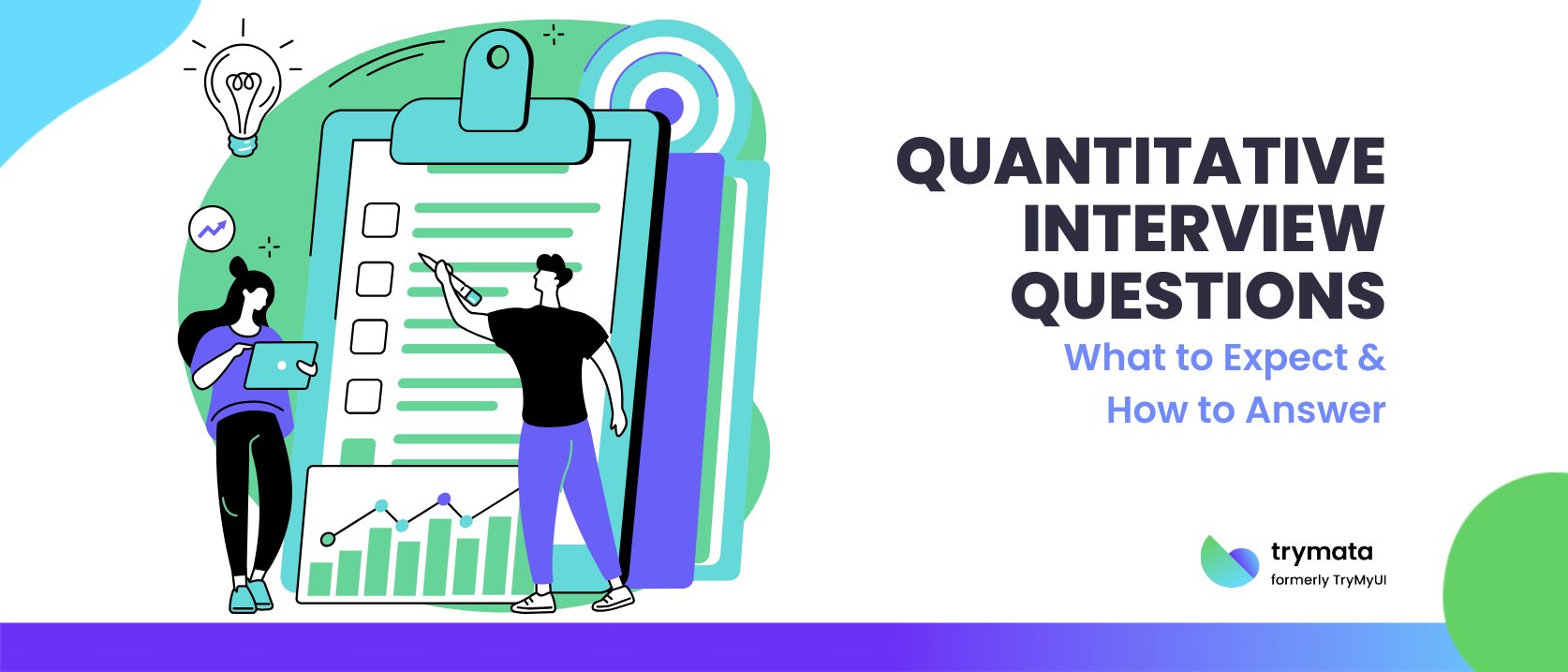Getting ready for a data-heavy interview can be intimidating, especially when you’re unsure what questions to expect. Whether you’re pursuing a role in quantitative finance, usability testing, or any other data-driven field, understanding how to tackle structured, numbers-based questions is key.
These interviews go beyond just knowing formulas. They’re about how you think, how you solve problems, and how well you can explain your approach.
In this blog, we’ll explain the different types of quantitative interview questions, how to craft or respond to them effectively, and what hiring managers are really looking for.
What are quantitative interview questions?
Quantitative interview questions evaluate how a person works with numbers, logic, and structured thinking. These questions are common in quantitative finance, usability testing, and data research, where analytical skills, attention to detail, and decision-making are critical.
For a quantitative analyst, these questions relate to financial markets, forecasting future prices, or estimating risk using historical data. For a user researcher or UX professional, similar techniques help uncover patterns in user behavior, validate decisions, and measure sentiment with precision.
No matter the context, interviewers are looking for someone who can think critically, explain their logic, and apply their knowledge in a structured way, whether building a pricing model or designing a user experience test.
Types of Quantitative Interview Questions
Depending on the role and the interviewer, questions may come in various formats:
1. Closed-Ended Questions
These require short, specific answers. Example:
What’s the sum of probabilities when rolling two dice and getting 7?
2. Multiple Choice
Used to check your understanding of statistics, financial markets, or probability. You might be asked to choose the best method to forecast future prices based on historical data.
3. Likert Scale
Often used in usability testing or user research to measure attitudes or preferences. For example:
How confident are you in using time series analysis? (Scale: 1 = Not confident to 5 = Very confident)
4. Semantic Differential Scale
This format places two opposing statements on a scale to measure perceptions.
Rate your comfort with logical reasoning: “Very uncomfortable” to “Very comfortable”
5. Ranking Questions
You may be asked to rank strategies based on risk, volatility, or expected return to assess your ability to prioritize and think critically.
6. Dichotomous (Yes/No) Questions
These tests are for fundamental experience or knowledge.
Have you used Monte Carlo simulation techniques to assess risk?
How to Craft Effective Quantitative Interview Questions
If you’re on the hiring side, it’s important to create questions that assess a candidate’s practical and theoretical understanding. Here are a few ways to structure them:
- Real-life application: Ask candidates to discuss how they would use statistical models to make investment decisions or estimate asset risk.
- Brain teasers: Use logic puzzles like the “three light switches” or “five-gallon jug” to evaluate problem-solving skills.
- Financial expertise: Questions could focus on stochastic processes, options pricing, or forecasting market volatility.
The goal is determining how people apply their knowledge to make sound judgments in complex situations.
Examples of Quantitative Interview Questions in Usability Testing
Sample questions test analytical thinking across finance and usability research, covering logic, probability, and decision-making.
1. Finance-Focused Scenarios
- Two dice are rolled. What’s the probability that the sum is greater than 10?
- Describe how you’d apply a Monte Carlo simulation to value an option.
- How would you assess volatility in a portfolio over time?
2. Usability Testing Scenarios
- Explain how you use a semantic differential scale to compare user preferences.
- How would you design a survey to measure task success and confidence?
- Discuss the use of Likert scale questions in a post-test questionnaire.
- How can you determine which light switch controls a bulb in another room if you can only enter once?
- Use a five-gallon and a three-gallon jug to measure exactly four gallons.
These questions are helpful across domains because they reveal how candidates think, not just what they know.
What Interviewers Want to See
A hiring manager isn’t just looking for someone who can spit out the correct answer. They’re assessing:
- How clearly you explain your reasoning
- Whether you can relate theoretical concepts to real-life finance problems
- Your comfort with data and probability
- The ability to make decisions with limited information
- Your attention to detail
Strong analytical skills, clear communication, and a good sense of strategy will help you stand out, whether you’re discussing hedge funds, asset management, or user research metrics.
Conclusion
Success in a quantitative interview isn’t just about getting the “right” answer. It’s about demonstrating your ability to think logically, analyze data, and communicate your reasoning.
Whether estimating risk in a financial portfolio or designing a usability test to understand user behavior, the fundamentals are the same: structure, strategy, and clarity.
With the right mindset and preparation, you’ll be ready to confidently take on brain teasers, probability puzzles, or real-world case questions and show you’re not just a good fit for the role, but the right one.




